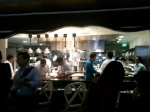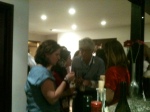It was around Noon Saturday, June 16 when the email came: “Another Kobrand Happy Hour!” It announced a reprise of the importer’s party from the night before.
This sort of thing is fairly routine at the Food & Wine Classic in Aspen. And this year it was even more so as the Classic celebrated its 30th anniversary. There were so many opportunities to attend receptions, dinners, parties and special tastings, to meet with winemakers, and discover new wines column I had to turn down several invitations and still can only briefly review my itinerary here. And this is what I like most about the Classic: for me at least, it is all about discovery. And this year, we all discovered a new restaurant concept, the Chef’s Club by Food & Wine on Thursday evening at an invitation only event before the official start of the Classic. The restaurant is housed in the St. Regis hotel and will feature menus devised by Food & Wine Best New Chefs. One of the inaugural chefs is Denver’s own Alex Seidel of Fruition. Kudos to Alex!
As always, the official kick off, though, was on Thursday with the Welcome Reception hosted by Trinchero Family Estates. The Trinchero family is one of California’s most influential, producing such highlyregarded brands (in addition to their namesake) as Napa Cellars, Terra d’Oro, Joel Gott, and Montevina.
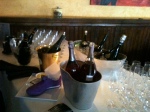 Next, it was off to Jimmy’s restaurant for a casual dinner hosted by Ferrer Wine Estates and featuringsome of their fine sparklers. While visiting with Eva Bertran, Executive Vice President at Freixenet USA, I enjoyed the Segura Viudas Reserva Heredad ($20) and Freixenet ElyssiaPinotNoir Brut from their extensive line of Cava. I also enjoyed talking and and tasting with Gloria Ferrer (the family’s California winery) winemaker Bob Iantosca. His limited release 2005 Anniversary Cuvee ($45) was especially complex and flavorful.
Next, it was off to Jimmy’s restaurant for a casual dinner hosted by Ferrer Wine Estates and featuringsome of their fine sparklers. While visiting with Eva Bertran, Executive Vice President at Freixenet USA, I enjoyed the Segura Viudas Reserva Heredad ($20) and Freixenet ElyssiaPinotNoir Brut from their extensive line of Cava. I also enjoyed talking and and tasting with Gloria Ferrer (the family’s California winery) winemaker Bob Iantosca. His limited release 2005 Anniversary Cuvee ($45) was especially complex and flavorful.
I concluded this first night at the annual Wines from Spain barbecue hosted by 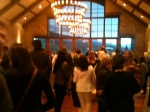 chef Jose Andres. Besidesgreat food, the event featured too many Spanish wines to taste them all or even keep tasting notes but I was impressed enough with the 2006 Bodegas Muga Reserva Seleccion ($40) to write it down in my notesand recommend it here. And that was just the first night! Friday night upped the ante.
chef Jose Andres. Besidesgreat food, the event featured too many Spanish wines to taste them all or even keep tasting notes but I was impressed enough with the 2006 Bodegas Muga Reserva Seleccion ($40) to write it down in my notesand recommend it here. And that was just the first night! Friday night upped the ante.
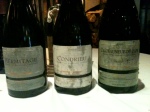 At a reception hosted by importer Wilson Daniels, the array of fine winesfrom their international portfolio was truly impressive. I felt like a kid in a candy store, as there were numerous wines that impacted me, from white Burgundy (Leflaive 2008 Pulighy-Montrachet, Laroche 2009 Reserve de l’Obedience Chablis Grand Cru and 2009 Petite Chablis) and Rhone Valley whites (Tardieu Laurent 2007 Hermitage, 2009 Condrieu and 2007 Chateauneuf-du-Pape) to Barbaresco (2005 Ceretto Bricco Asili), Tokaji Aszu (1999 Royal Tokaji 6 Puttanyos), and California Cabernet Sauvignion (2008 Lancaster Estate). Whew!
At a reception hosted by importer Wilson Daniels, the array of fine winesfrom their international portfolio was truly impressive. I felt like a kid in a candy store, as there were numerous wines that impacted me, from white Burgundy (Leflaive 2008 Pulighy-Montrachet, Laroche 2009 Reserve de l’Obedience Chablis Grand Cru and 2009 Petite Chablis) and Rhone Valley whites (Tardieu Laurent 2007 Hermitage, 2009 Condrieu and 2007 Chateauneuf-du-Pape) to Barbaresco (2005 Ceretto Bricco Asili), Tokaji Aszu (1999 Royal Tokaji 6 Puttanyos), and California Cabernet Sauvignion (2008 Lancaster Estate). Whew!
From there it was a short walk to Mezzaluna restaurant where I enjoyed several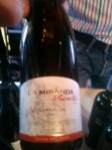 delectables with fine wines from Portuguese winery Esporao. My favorite at thistasting was the 2009 Esporao Reserva ($20), an enticing blend of indigenous and international varieties.
delectables with fine wines from Portuguese winery Esporao. My favorite at thistasting was the 2009 Esporao Reserva ($20), an enticing blend of indigenous and international varieties.
Next, it was just across the street to the first Kobrand “happy hour” where I was greeted with a flute of Champagne Laurent-Perrier Brut. I sipped the refreshing bubbly as I chatted with Jacques Lardiere, the great (though now retiring) winemaker of Louis Jadot, the famed Burgundy producer. Then I got myself a taste of his fine 2006 Louis Jadot Pommard “Clos de la Commaraine.)
Saturday night was even more packed. It began with a tasting hosted by the importer Moet Hennessy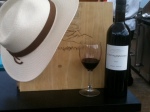 USA.This tasting featured just one wine, and an Argentinean wine at that: the 2007 Cheval des Andes ($80). This wine, a joint venture between Terrazas de Los Andes and Chateau Cheval Blanc, blends cabernet sauvignon, malbec and petite verdot into a wine that rivals the best of Bordeaux. It was so special it seemed perfectly appropriate that it was the only one at the tasting.
USA.This tasting featured just one wine, and an Argentinean wine at that: the 2007 Cheval des Andes ($80). This wine, a joint venture between Terrazas de Los Andes and Chateau Cheval Blanc, blends cabernet sauvignon, malbec and petite verdot into a wine that rivals the best of Bordeaux. It was so special it seemed perfectly appropriate that it was the only one at the tasting.
 Then it was to the reprise of the Kobrand happy hour. And what a treat it was to have a chance to taste many of the great Lousi Jadot Burgundies, wines even wine writers seldom get to taste. Just look at this line up! 1978 Chevalier Montrachet les Demoiselles1978 Bonnes Mares 1985 Gevrey Chambertin Clos St. Jacques 1986 Batard Montrachet 1989 Vosne Romanee Suchots 1990 Chambertin Clos de Beze 1991 Corton Charlemagne 1996 Beaune Greves 1996 Corton Pougets 1999 Meursault Genevrieres.
Then it was to the reprise of the Kobrand happy hour. And what a treat it was to have a chance to taste many of the great Lousi Jadot Burgundies, wines even wine writers seldom get to taste. Just look at this line up! 1978 Chevalier Montrachet les Demoiselles1978 Bonnes Mares 1985 Gevrey Chambertin Clos St. Jacques 1986 Batard Montrachet 1989 Vosne Romanee Suchots 1990 Chambertin Clos de Beze 1991 Corton Charlemagne 1996 Beaune Greves 1996 Corton Pougets 1999 Meursault Genevrieres.
After that, I hopped in my car and made my way to the Old Smuggler Mine on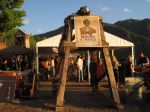 the outskirts of the town for the “S’wine at the Mine” festivities hosted by Denver’s Infinite Monkey Theorem (IMT) winery. Paired with multiple preparations of pork products, IMT poured its Blind Watchmaker Red Blend, Sauvignon Blanc, and sparkling wines packaged in cans!
the outskirts of the town for the “S’wine at the Mine” festivities hosted by Denver’s Infinite Monkey Theorem (IMT) winery. Paired with multiple preparations of pork products, IMT poured its Blind Watchmaker Red Blend, Sauvignon Blanc, and sparkling wines packaged in cans!
But, quite frankly themost incredible event of the evening (at least for the wine hedonist in me) was the importer Old Bridge Cellars’ gathering of Australia’s d’Arenberg wines hosted by Winemaker Chester Osborn. In celebration of d”Arenberg’s 100th anniversary, they offered library wines and a chance to taste through the new “Amazing Sites” Collection (14 single site Shiraz and Grenache wines). There’s just too much to go into here. Suffice it to say I was blown away by the breadth and depth of quality on display. I hope to write more about these amazing wines later.
The Classic provided me many other prospects for discovery available at the Classic. Next week I will share more incredible tasting experiences in Aspen, this time outside of the Grand Tasting Tent.




